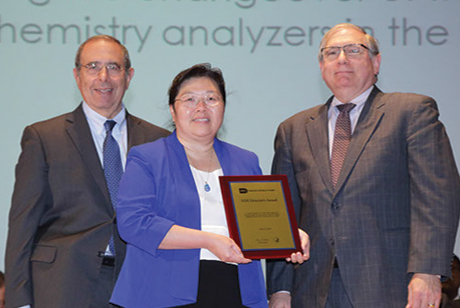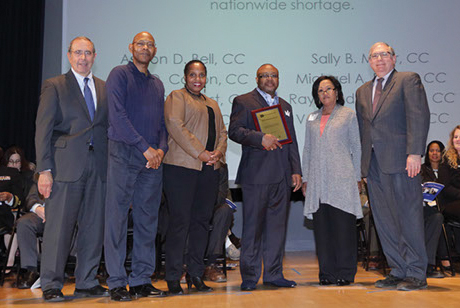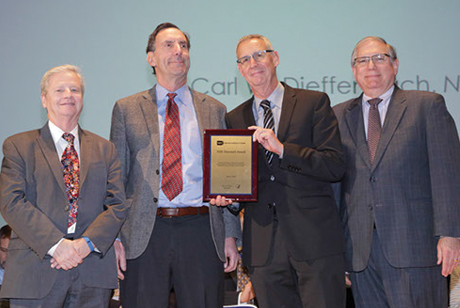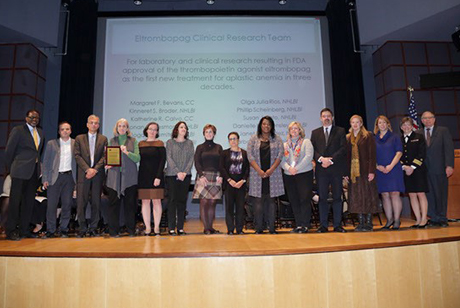

December 2015
IN THIS ISSUE:
![]()
- Patient shares hope for therapeutic vaccine as potential HIV treatment
- Patients naturally immune to HIV participate in NIAID study
- Sixty-four gingerbread houses dazzle patients, staff and guests
- Rehabilitation Medicine Dept. looks to exercise as treatment for patients with lung disease
- A decade of dedication: supporters of Safra Family Lodge gather for anniversary
- Clinical Center staff recognized for outstanding achievements
- The 6th annual Caregiver Day helps relieve stress, support families
- Doctor's Caucus visits NIH Clinical Center
- Clinical trials at NIH Clinical Center in need of participants
- NIH recognizes its military veterans
- Upcoming Events
Print this Issue ![]() (432 KB)
(432 KB)
ABOUT CC NEWS:
![]()
Published monthly by the Office of Communications and Media Relations. News, article ideas, calendar events, letters, and photographs are welcome. Submissions may be edited.
Clinical Center News
National Institutes of Health
Building 10, 10 Center Drive
Room 6-2551,
Bethesda, MD 20892-1504
Tel: 301-594-5789
Fax: 301-402-0244
Molly.hooven@nih.gov
2015 ISSUES:
![]()
QUICK LINKS:
![]()
 |
In honor of World AIDS Day on Dec. 1, CC News is embracing the 2015 Federal theme, The Time to Act is Now, by highlighting HIV/AIDS research at NIH. Nearly 45 studies are taking place in the Clinical Center on HIV/AIDS. Learn more about the research, resources and read the NIH 2015 statement on World AIDS Day. |
Patient shares hope for therapeutic vaccine as potential HIV treatment
 |
Between appointments Robert Wilkinson, a participant in a NIAID trial, enjoys playing the piano for visitors and other patients on the 7th floor. Above, he and a friend, played and sang during his June 2015 visit. |
Vaccine or placebo? For Robert Wilkinson, either one is a win. Wilkinson is participating in a National Institute of Allergy and Infectious Diseases (NIAID) trial at the Clinical Center to see whether a therapeutic vaccine for human immunodeficiency virus (HIV) is safe and can affect how the body responds to HIV infection.
"If I could benefit from this study myself, I would be thrilled! It'd be awesome if I was taking a vaccine once a month instead of pills every day," he said. "But, the biggest thing for me, and the reason I want to be a part of the study, is so that we don't confuse movement and progress. A lot of people are like 'Well HIV isn't really a big deal. No one dies of acquired immune deficiency syndrome (AIDS) anymore.' But I always tell my friends just because we've made a lot of progress doesn't mean that we are done. And it doesn't mean we can't be a part of the reason that things continue to progress."
Wilkinson is one of about 30 patients who are participating in this Phase 1 trial led by Dr. Michael Sneller, of the NIAID Laboratory of Immunoregulation. In the vast majority of people infected with HIV, the immune system cannot control or cure the infection. Treatment with anti-HIV drugs is needed to keep the virus at a level low enough to limit the negative impact on the patient's health.
"We're in the early stages of looking at providing a therapy for HIV with a vaccine instead of medication," Sneller said. "We want to see if a series of vaccinations can sufficiently boost the immune system response to HIV to allow the infection to be controlled without the need for daily medications."
To be clear, it's not a vaccine to cure HIV or a preventative measure, but rather an updated treatment approach, Sneller said.
Wilkinson, an avid traveler for his career as a pianist, composer and off-Broadway musical director, looks forward to the potential for him and other HIV patients to cut the ties with their medications.
"I can't wait. To be perfectly honest, I'm so thrilled," he said. "Right now, when I travel, I have to worry about my medication coming with me and how much do I have and are they going to think it's weird that I have that much. The moment I don't require taking medication anymore, I have the ability to do more with my life and be more free."
In early 2016, after nearly a year of being enrolled in the trial, he will stop his HIV medications. With his health being key, he will be monitored closely and immediately go back on his medications if the level of HIV in his blood becomes too high, his CD4 lymphocyte count shows a significant decline or he develops any symptoms related to active HIV infection. Otherwise, he will remain off antiretroviral drugs for four months to determine if the vaccine was effective at boosting the immune response to HIV enough to keep the levels of virus low.
"I come from a generation of people where HIV isn't really a scary thing any longer," Wilkinson said. "One of the things that my generation of gay men don't have the opportunity to do is to fight for a cause. For myself, it was nice to be able to do something for the population of people that this affects. The research is necessary in order for things to improve. I think that one of the things that scares me as someone who has HIV is that we don't push hard when we're doing well. We don't fight for change when the change that's necessary isn't as significant as it once was. I like that the NIH has given me the option to have a voice."
Patients naturally immune to HIV participate in NIAID study
The human immune system is a network of cells, tissues and organs that work together to protect the body from infection and, for some people, this includes protection from the human immunodeficiency virus (HIV). Dr. Stephen Migueles, an expert in the National Institute of Allergy and Infectious Diseases (NIAID), has spent over 20 years studying the body's immune response to HIV. During that time, he and his mentor Dr. Mark Connors, also with NIAID, have developed protocols designed to study very rare types of immune responses. Their patients have had HIV for decades without any disease progression, HIV-related illness or the virus developing into acquired immune deficiency syndrome (AIDS).
Now, Migueles and Connors are on the search for how these patients control the HIV and how they can transfer that control mechanism to help other patients. Currently, there are an estimated 1.1 million people in the United States and 34 million people globally who are living with HIV. They hope that the findings of the study will allow them to better understand the nature of effective HIV-specific immunity and focus on future vaccine design efforts.
About 250 patients are participating in the doctors' current protocol. Each year, these patients come to the Clinical Center and have blood work done to understand their disease and their individual immune responses. There are 115 patients in the study who are able to control HIV; the other patients help Migueles understand the "normal" progression of HIV.
There are two types of immune responses that have been shown to control HIV. The first can be seen in naturally-occurring controllers. These patients use a T-cell response to control HIV. T cells help the body fight diseases or harmful substances.
The second immune response can be seen in patients who have large amounts of antibodies to HIV in their systems. A human's B cells often mature into plasma cells that produce antibodies needed to fight off infections. Some individuals living with HIV make potent antibodies that neutralize HIV and block its ability to infect other immune cells in their systems. The level of control over HIV in these individuals is less than that observed in naturally-occurring controllers.
"It isn't the virus," said Migueles. "It's the host." Each person's individual immunity decides if and how they will control HIV.
One of Migueles' patients, Karen Pancheau, has lived with HIV for 33 years without it's turning into AIDS and without virus-related illness. Infected during a transfusion when she was pregnant in 1982, she transferred the infection to her son, not knowing that she was infected. Even though Pancheau's body can control her HIV infection, her son's body, which had the same type of HIV, could not. He was seriously affected by his disease, and he ended up taking his own life in reaction to his illness.
Pancheau comes back to the Clinical Center once a year to contribute to Migueles' protocol. She has the same physical ailments of anyone else her age but still remains free of HIV/AIDS-related symptoms.
"I got involved [here at NIH] because I couldn't save my son, but maybe I can save someone else's son or daughter," said Pancheau. In regards to my health, I've never been on HIV medication but "basically, I'm healthy. I need to do the things that all of us need to do, eat better and exercise more, but I can't complain."
Migueles hopes to use the information he gathers from patients like Pancheau to make sure that one day, NIH can lead the efforts in developing a vaccine that will help all patients control HIV and live healthier, longer lives.
Sixty-four gingerbread houses dazzle patients, staff and guests
The NIH Clinical Center held the 12th annual Gingerbread House Decorating Contest enjoyed by staff, patients and visitors. This year, more than 8,500 votes were submitted, 6,100 of which were cast on the Clinical Center Facebook page. The social media site drew 2,000 more votes than last year online! Winners, through in person ballots include: 1st place - Rehabilitation Medicine Department Team, NIH Clinical Center, 2nd place - Primary Immune Deficiency Clinic, National Institute of Allergy and Infectious Diseases (NIAID) and 3rd place - Pacak's Lab, Eunice Kennedy Shriver National Institute of Child Health and Human Developmen (NICHD). The Facebook winners include: 1st place - Pacak's Lab, NICHD, 2nd place - Management Services Branch (NIAID) and 3rd place - The Circulators - Post Docs and Post Bacs in the Division of Developmental Biology, NICHD. The gingerbread houses will remain on display through Jan. 4, 2016.
 |
First place Facebook winner and third place paper ballot winner is Pacak's Lab from Eunice Kennedy Shriver National Institute of Child Health and Human Development. |
 |
First place winner, through in person ballot voting, is Rehabilitation Medicine Department Team's Mario Kart. |
 |
Maya Lodish (right), employee at Eunice Kennedy Shriver National Institute of Child Health and Human Development admires the houses with daughter Talia Zimmerman. |
Rehabilitation Medicine Dept. looks to exercise as treatment for patients with lung disease
 |
Krishna Jain, and other trial participants go on the treadmill and are fitted with a mask, electrodes and light sensors to measure how well the heart is working and how well the muscles use oxygen. |
Patients who have interstitial lung disease have inflammation that makes it very hard to breathe. One of the last things you'd think they'd be doing is exercising. And yet, experts at the NIH Clinical Center's Rehabilitation Medicine Department are hoping their trial will do just that — use exercise as a potential mental and physical treatment for patients with this disease.
After having tested this theory in 2012 to help patients with pulmonary hypertension, researchers are performing a similar trial in patients with interstitial lung disease, which causes scarring of lung tissue and stiffness in the lungs.
The randomized trial involves patients referred by their physicians or by Inova Fairfax Hospital, a collaborator on the study, along with George Mason University.
In the study, there are two groups of study participants. The first group walks on the treadmill 30 to 45 minutes, three times a week for 10 weeks, as well as receiving educational lectures regarding their disease. The second, control group, receives only the education portion for 10 weeks. Researchers will test mental and physical wellbeing before and after the 10 week program, and collect monthly information regarding exercise habits for a year after the trial is completed.
The main measure of the trial is how well patients tolerate a 6-minute walk test after completing the 10 week program. This standard test measures a patients' endurance by determining how far a patient can walk within 6 minutes. The trial will also assess whether exercise can increase patients' physical and mental health, as well as the tolerability and safety of exercise in patients with lung disease. The hope is that exercise can help patients both physically and mentally, even if their lung function stays the same with their disease.
"This intensive study is ideal for the NIH Clinical Center, where we can watch patients carefully, study their reactions in-depth, and see patients frequently," said Dr. Leighton Chan, chief of the Rehabilitation Medicine Department. "With these resources, we are starting to view and test exercise as any other drug used for treatment."
Krishna Jain, a patient and 27-year-employee of the NIH Center for Scientific Review, completed the study.
"I really liked the attention and real concern about my health that I experienced at the NIH Clinical Center," said Jain. "The protocol has helped me maintain a regular exercise routine."
The Rehabilitation Medicine Department is looking to expand studies using exercise as a treatment in patients with Traumatic Brain Injuries.
 |
Members of the Exercise and Applied Physiology Research Lab, include Anne Quinn, Dr. Leighton Chan, chief of Rehabilitation Medicine Department and Principal Investigator of the study, Dr. Randall Keyser and Dr. Lisa Chin from George Mason University and Marybeth Stockman. |
A decade of dedication: supporters of Safra Family Lodge gather for anniversary
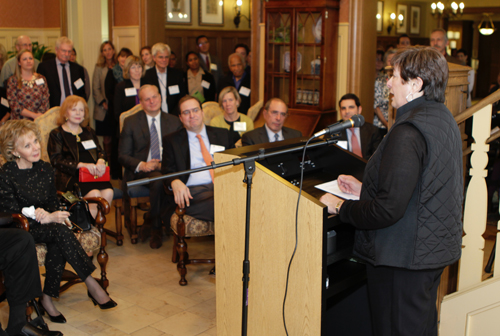 |
Julie Gattini, who traveled to the NIH with her husband nearly 10 years ago, spoke at the anniversary celebration of the lodge. |
NIH staff, patients and supporters of The Edmond J. Safra Family Lodge gathered in early November to celebrate the building's 10th anniversary of serving families and loved ones of adult patients who are receiving care at the NIH Clinical Center.
During the open house event on Nov. 5, Dr. John I. Gallin, the director of the Clinical Center, emphasized the importance and great impact the facility has on the NIH.
"The Family Lodge has played a vital part of NIH's dual mission to advance basic knowledge and to improve human health. When patients and their families come here, they don't have to worry about staying in their cars; they can stay right across the street from the Clinical Center. I have seen firsthand the healing power of loved ones being near the patients when they're sick. I also know that the researchers from the 14 NIH institutes and centers who use this lodge feel particularly grateful to have their patients staying in close proximity to the hospital and to the care that they need."
The lodge, which opened in 2005, includes 34 guest rooms, a library, business center, fitness area, kitchen, laundry, outdoor gardens and walking paths. It was named after Edmond J. Safra, a private banker and philanthropist who was committed to advancing medical research and humanitarian causes. His wife, Lily, serves as a founding member of the Foundation for NIH and has continued to carry on her husband's legacy after his death in 1999.
"Fortunately for patients whose care providers have called the Family Lodge home, today's honored guest, Lily Safra, did not forget the experience she had caring for her late husband," Gallin said. "Her enduring empathy for the plight of caregivers manifests itself in this gift [of the lodge]. This place works. All you have to do is look at the patients and speak to the patients, and you'll capture that."
Numerous current and past patients and their families also gathered at the event including Julie Gattini, who traveled to the NIH with her husband nearly 10 years ago. Her husband's 'biggest concern' about the trip to NIH wasn't preparing to have his second kidney removed, but rather 'where [Julie] was going to stay, would [Julie] be able to handle the traffic, how much time would [Julie] spend with him," she said.
"All that was alleviated when they accepted me here at Safra Lodge," Gattini said. "I would get up in the morning and go down to the beautiful kitchen, have a delicious blueberry bagel and a cup of coffee, and I was off to the hospital. Feeling that the lodge was my home for 10 days gave me comfort and security. I just want to thank you Mrs. Safra for your generosity and for giving so much of yourself because you affected so many people. On behalf of everyone who has walked through those doors and has stayed here and the memories, etched in their minds and in their lives, of how important this place is, thank you."
The lodge runs on a public-private partnership. The Foundation for the NIH, The Edmond J. Safra Philanthropic Foundation, the Bristol-Myers Squibb Foundation, The Merck Company Foundation, GlaxoSmithKline, and other individuals, corporations, and foundations made the Safra Family Lodge a reality.
Clinical Center staff recognized for outstanding achievements
At an institution renowned for its innovations with chemotherapy, the use of nitroglycerin to treat heart attacks and the creation of blood tests to identify both Acquired Immune Deficiency Syndrome (AIDS) and hepatitis, it can be a little hard to stand out. On Nov. 17, over 100 staff from the NIH Clinical Center did just that, receiving recognition from Dr. Francis S. Collins, director of the NIH, for their outstanding contributions over the past year.
The NIH Director's Awards are intended to recognize exceptional performance and special efforts of NIH staff that are directly related to fulfilling the NIH mission.
|
| |||||
|
|
Five Clinical Center staff received individual awards recognizing their contributions to mentoring, leadership and customer service.
- Colleen A. McGowan was recognized for exemplary performance while demonstrating significant leadership, skill and ability in serving as a mentor.
- Capt. Antoinette L. Jones was noted for her exceptional leadership and innovation employed to enhance service delivery, provide consistent management across all modalities and improve internal and external partnerships.
- Rita W. LaPointe received recognition for outstanding leadership in managing the General Chemistry section and implementing the changeover of the high-volume chemistry analyzers in the Department of Laboratory Medicine.
- Robert B. Mekelburg was recognized for outstanding leadership and continued commitment to quality, efficiency and exceptional customer service within the Materials Management and Environmental Services Department and the Clinical Center. (Not Photographed)
- Annie L. Harrison was noted for her unflagging commitment to the provision of exceptional customer service to guests staying at the Edmond J. Safra Family Lodge.
| ||||||
|
| |||||
Clinical Center staff were also recognized through group awards for their exceptional service.
- The NIH Ebola Patient Care Response Team was noted for their exceptional care of patients exposed to or infected with Ebola virus, and the extraordinary support for NIH staff providing that care. (Read more on this story: http://go.usa.gov/cYMf5)
- The Clinical Center Receiving Team received accolades for maintaining accountability and accuracy for the broad scope of intravenous solutions distributed throughout the Clinical Center during a nationwide shortage. (Read more on this story: http://go.usa.gov/cYMfj)
- The Clinical Center Supply and Distribution Team was recognized for their coordination and distribution of medical supplies for Ebola patients, a supply-intensive patient population.
|
| |||||
|
|
Five other individuals and groups in the Clinical Center were nominated for their work by other NIH Institutes.
- Henry Masur was nominated by the National Institute of Allergy and Infectious Diseases (NIAID). His work with the D.C. Partnership for AIDS Progress Team developed an innovative intramural/extramural and Federal/ local partnership that is having enormous impact on urban HIV/AIDS in Washington, D.C., and nationally. (Read more on this story: http://go.usa.gov/cYMG4)
- Kenneth Kindrachuck was nominated by NIAID for his work with the Clinical Center's Ebola Diagnostic Team which provided overseas support of Ebola diagnostic efforts in West Africa.
- The Eltrombopag Clinical Research Team was nominated by the National Heart, Lung, and Blood Institute for laboratory and clinical research resulting in Food and Drug Administration approval of the thrombopoietin agonist eltrombopag as the first new treatment for aplastic anemia in three decades.
- Christine Grady was nominated by the National Human Genome Research Institute for her work with the Genetic Association Information Network in developing and implementing new models for genome-wide data sharing. (Not Photographed)
- The Niemann-Pick Disease Type C Collaboration Team was nominated by the National Institute on Child Health and Human Development for contributions to a collaborative effort among government, academic and industry researchers and patient groups to develop a therapy for Niemann-Pick disease type C.
Congratulations to the Clinical Center and other NIH staff for their outstanding contributions. Look for coverage of the Clinical Center Director's Awards in the January issue of CC News.
The 6th annual Caregiver Day helps relieve stress, support families
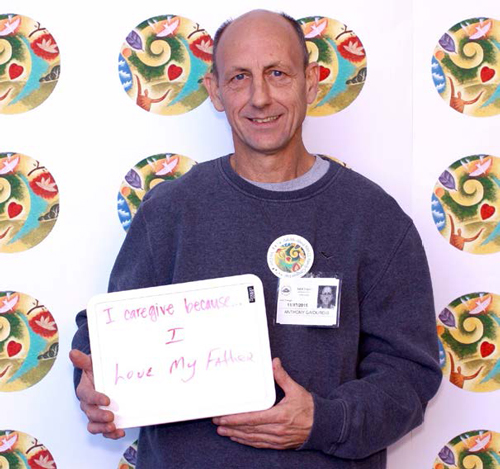 |
Caregiver Tony Gaidurgis participated in the photo booth and wrote “I caregive because I love my father.” |
On Nov. 17, Clinical Center staff hosted Family Caregiver Day in celebration of National Family Caregiver Month.
"The program has been an asset for the NIH for six years now, and its continued success is a direct reflection of the Clinical Center's passion and commitment to patients and their caregivers," said Commander Margaret Bevans, a clinical nurse scientist within the Nursing Department. "The event, website and Facebook page [disclaimer] provide caregivers with resources and help them realize their importance."
 |
Clinical Center staff participate in the photo booth and hold up signs that say "I love Caregiver Day," "Caregiving is love" and "Caregiving is my purpose.” |
The day included a caregiver photo booth which had white boards for participants to share what caregiving meant to them as well as an acapella performance by the NIH Nerds in Harmony.
An introduction to creative ways to reduce stress was also shared, including an interactive workshop on yoga, meditation, reiki, seated massage and Zentangles (creative drawing).
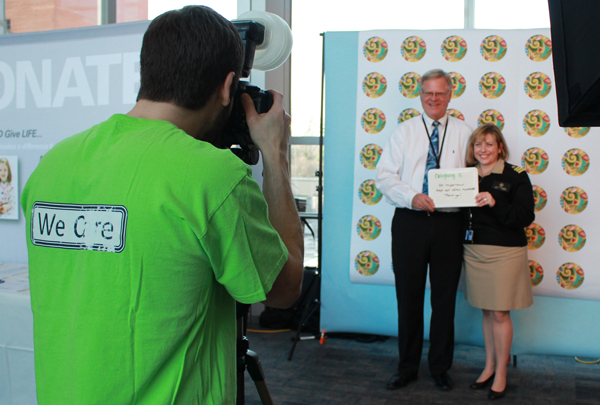 |
Staff, Alan Decot and CDR Leslie Wehrlen proudly display a sign that says caregiving is so important and not often appreciated. Thank you! |
Perry Gaidurgis and his brother Tony Gaidurgis became caregivers to their father this year and attended the event.
"I am looking for support in navigating the various needs as a caretaker to my family members and seeing what resources I might not be aware of to help provide support," Perry said.
As a caregiver, "You can still have a freedom to express your negative emotions instead of caretaking to the point that you're not taking care of yourself," he added.
Doctor's Caucus visits NIH Clinical Center
Five members of the House Republican Doctors Caucus—a group of 18 medical providers in Congress who use their expertise to shape health care policy—visited NIH Nov 16. NIH Director Dr. Francis Collins welcomed the group to the Clinical Center's medical board room for updates on the BRAIN (Brain Research through Advancing Innovative Neurotechnologies) and Precision Medicine initiatives, among other topics. Participating in the briefing were (left to right) Rep. Larry Bucshon (Indiana), Reps. Diane Black and Phil Roe (both of Tennessee), Rep. Andy Harris (Maryland) and Rep. Ralph Abraham (Louisiana). |
Clinical trials at NIH Clinical Center in need of participants
NIDDK seeks healthy Caucasian females, 18-35 years old to participate in a research study. Doctors want to learn how the body burns energy at different temperatures. You will have an 8-day inpatient stay at the NIH Clinical Center. Compensation is provided. (Study #12-DK-0097)
An NIDDK research team seeks people with fatty liver disease to participate in a study. Researchers are looking at a breath test to measure how the body breaks down food in people with fatty liver disease. If have been diagnosed with non-alcoholic fatty liver disease or steatohepatitis you may be interested in participating. Compensation is provided. (Study# 15-DK-0080).
For more information on the studies above or others available, call the NIH Office of Patient Recruitment 1-866-444-2214, (TTY 1-866- 411-1010) or visit www.clinicaltrials.gov.
NIH recognizes its military veterans
 |
Cathy Troutman, a retired Army lieutenant colonel now working at the National Heart, Lung, and Blood Institute lifts a rose from the Remembrance Table at the NIH Veterans day Celebration Nov. 5 in the Masur Auditorium at the NIH Clinical Center. The table honors US military who are prisoners of war and/or missing in action. Each item on the table has significance – the single red rose is to remind all of the POW/MIA's family and loved ones. |
The National Institutes of Health recognized its military veterans with an NIH Veterans Day Celebration in the Masur Auditorium at the NIH Clinical Center Nov. 5. The US Navy Ceremonial Guard was on hand to post the colors at the start of the event. About 1,000 US military veterans are employed at NIH, more than 100 at the NIH Clinical Center.
Glenda Conroy, a retired Air Force Reserve captain who is now the director of the NIH Office of Financial Management, gave the Welcome address. Conroy recounted some of the memorable events of her service as examples of how military service molds character.
The keynote speaker was retired Army colonel Donald A. Gagliano who founded Global Medical Innovation, a company designed to discover and implement innovative solutions for research and development.
The event included recognition of the Remembrance Table to honor US military who are prisoners of war and/or missing in action.
 |
From left to right, Kelley Henry, an Army sergeant now working at the National Institute of Allergy and Infectious Diseases (NIAID); Cathy Troutman, a retired Army lieutenant colonel now working at the National Heart, Lung, and Blood Institute; Chris Pugh, a retired Army first sergeant now working at the NIH Office of Human Resources; Michael Nealy, PhD, a sergeant in the Marine Corps now working at the NIAID; George Fleming, a chief petty officer in the Navy now working at the NIH Office of Research Facilities (ORF); Daniel Lid, a major in the Air Force now working at the NIH ORF; and Winston Kingkade, a petty officer first class in the Coast Guard now working at the NIH Office of Human Resources attend the NIH Veterans day Celebration Nov. 5 in the Masur Auditorium at the NIH Clinical Center. The seven wore their military uniforms to conduct the Remembrance Table recognition during the celebration. |
Upcoming Events
Most lectures will be streamed live and archived
12th Annual Gingerbread House Decorating Contest
Dec. 7, 2015 – Jan. 3, 2016
Atrium
Vote for your favorite decorated house in the Clinical Center's north atrium or on Facebook, and get into the holiday spirit. Contact Ann Marie Matlock for more information.
Clinical Center Grand Rounds Lecture
Homeostatic Control of Calorie Intake in Humans and its Role in Obesity Treatment; Human Brown Adipose Tissue and Its Role in Treatment of Metabolic Diseases
Jan. 6, 2016, Noon – 1:00 p.m.
Lipsett Amphitheater
Presented by Kevin Hall, PhD, NIDDK and Aaron Cypess, MD, PhD, NIDDK.
NOTE: PDF documents require the free Adobe Reader.
 The information on this page is archived and provided for reference purposes only.
The information on this page is archived and provided for reference purposes only.

